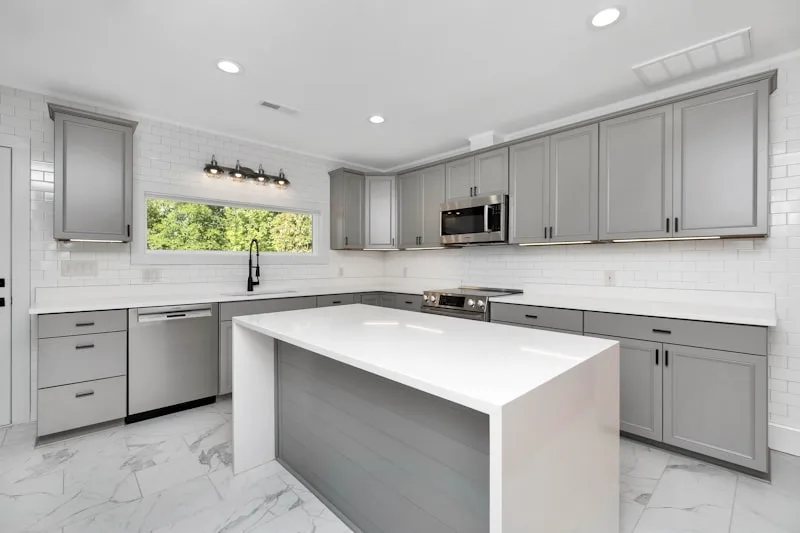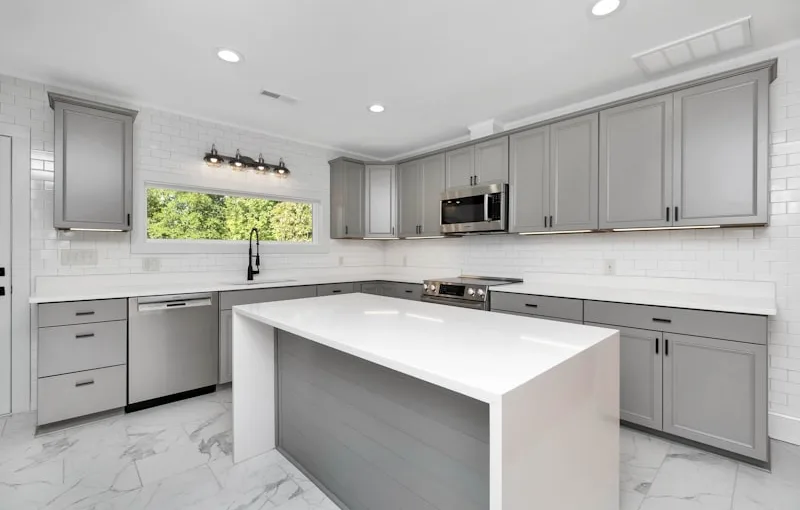Typically, the standard distance between the bottom of your upper cabinets and the top of your lower cabinets is around 18 inches. This space is like the sweet spot for most kitchens, allowing enough room for your countertop appliances and giving you easy access to your cooking essentials. But hey, if you’re a tall person or just love to have a lot of countertop space, you might want to consider increasing that distance to 20 or even 24 inches. It’s all about what works best for you!

Now, think of it this way: the distance between your cabinets is like the space between notes in a song. Too close, and it feels cramped; too far apart, and it loses its rhythm. You want that perfect harmony where everything flows smoothly. Plus, having that extra space can make your kitchen feel more open and inviting, which is a huge plus when you’re entertaining guests or just whipping up a weeknight dinner.
So, whether you’re planning a full kitchen remodel or just tweaking your current setup, keep that distance in mind. It’s one of those little details that can elevate your kitchen from functional to fabulous!
The Perfect Fit: How to Measure the Ideal Distance Between Your Kitchen Cabinets
First off, think about functionality. You want your kitchen to be a space where you can whip up a gourmet meal without feeling cramped. A good rule of thumb is to leave at least 15 to 18 inches between the countertop and the bottom of your upper cabinets. This distance allows for ample workspace while keeping everything within arm’s reach. Imagine trying to chop veggies with your elbows bumping into the cabinets—no thanks!
Next, consider the height of your family members. If you’re on the taller side, you might want to raise those upper cabinets a bit higher. Conversely, if you have little ones who love to help out, keeping them lower can make cooking a family affair. It’s all about creating a space that feels comfortable for everyone.
Now, let’s talk about aesthetics. The distance between your cabinets can also affect the overall look of your kitchen. A wider gap can create a more open feel, while a tighter fit can give a cozy, intimate vibe. Think of it like the difference between a spacious living room and a snug reading nook—both have their charm, but they serve different purposes.
Cabinet Spacing 101: Finding the Sweet Spot Between Top and Bottom Units
First off, let’s talk about height. Ideally, the space between your upper and lower cabinets should be around 18 inches. This isn’t just a random number; it’s the perfect distance for functionality and aesthetics. Imagine trying to reach for a spice jar while ducking under a cabinet—no fun, right? That 18-inch gap allows for easy access and gives your kitchen a balanced look.
Now, let’s consider the ceiling height. If you’ve got lofty ceilings, you might be tempted to stretch those upper cabinets all the way up. But hold on! Leaving a little space at the top can create a visual break, making the room feel more open. It’s like giving your kitchen a breath of fresh air.
And what about the bottom cabinets? If you’re planning to install a countertop, remember that the standard height is about 36 inches. This height is designed for comfort, so you’re not hunched over while chopping veggies. Pair that with the right spacing above, and you’ve got a kitchen that’s not just beautiful but also functional.
So, as you’re mapping out your cabinet layout, think about how each piece interacts with the others. It’s all about balance—like a well-crafted recipe. Too much of one thing can throw off the whole dish, but the right proportions create a kitchen that’s both stunning and practical.
From Floor to Ceiling: The Science Behind Kitchen Cabinet Height and Spacing
First off, let’s talk about height. The standard cabinet height is usually around 30 inches for base cabinets and 36 inches for wall cabinets. But here’s the kicker: your personal height matters! If you’re on the taller side, you might want to consider raising those wall cabinets a bit higher. It’s like adjusting the seat in your car; you want to be comfortable and in control.
Now, spacing is just as crucial. You don’t want to feel like you’re playing a game of Tetris every time you reach for a spice jar. Ideally, there should be about 18 inches between the countertop and the bottom of the wall cabinets. This gives you enough room to work without feeling cramped. Think of it as the sweet spot—too little space, and you’re bumping your head; too much, and you’re stretching like a gymnast just to grab that olive oil.
Maximizing Space: The Essential Guide to Cabinet Distances in Modern Kitchens
First off, let’s talk about the magic number: 15 inches. That’s the sweet spot for the distance between your countertop and upper cabinets. Why? It gives you enough room to work without feeling cramped, like trying to dance in a phone booth. You want to chop veggies and stir sauces without bumping your head or knocking over a spice jar.
Now, what about the space between cabinets? Ideally, you want at least 36 inches between your kitchen island and surrounding cabinets. This distance is like giving your kitchen a personal bubble—enough room for multiple chefs to work their culinary magic without stepping on each other’s toes. Picture it: you’re sautéing while your partner is kneading dough, and there’s no chaos in sight!
And let’s not forget about the height of your cabinets. If you’re going for that sleek, modern look, consider installing cabinets that reach the ceiling. This not only maximizes vertical space but also gives your kitchen a polished, spacious feel. It’s like adding a cherry on top of a sundae—totally elevates the whole vibe!
So, whether you’re a seasoned chef or a weekend warrior, understanding cabinet distances can transform your kitchen into a functional and stylish space. It’s all about creating an environment where you can whip up your favorite meals without the hassle. Who wouldn’t want that?
Frequently Asked Questions
How Far Should Upper Cabinets Be from Lower Cabinets?
The ideal distance between upper and lower cabinets is typically 18 inches. This height allows for comfortable workspace and accessibility while ensuring that the upper cabinets are easily reachable without obstructing movement in the kitchen.
What is the Standard Height Between Kitchen Cabinets?
The standard height between kitchen cabinets typically ranges from 18 to 24 inches above the countertop. This spacing allows for comfortable access to kitchen items while ensuring adequate workspace and functionality.
How to Measure the Distance Between Kitchen Cabinets Correctly?
To accurately measure the distance between kitchen cabinets, start by using a tape measure. Measure from the edge of one cabinet to the edge of the adjacent cabinet, ensuring the tape is straight and level. Record the measurement at the widest point to account for any irregularities. Repeat this process at different heights if necessary, and always double-check your measurements for precision.
What Factors Affect Cabinet Height Measurements?
Cabinet height measurements are influenced by several factors including ceiling height, the intended use of the cabinets, ergonomic considerations, and design preferences. Standard heights typically range from 30 to 36 inches for base cabinets and 84 to 96 inches for wall cabinets. Customization may be necessary to accommodate specific kitchen layouts or user needs.
Is There a Recommended Distance for Kitchen Cabinet Spacing?
Proper spacing between kitchen cabinets is essential for functionality and aesthetics. A common recommendation is to maintain a distance of 18 to 24 inches between the countertop and upper cabinets to ensure ease of use and accessibility. Additionally, consider leaving at least 3 inches between cabinets and appliances to allow for proper ventilation and movement.
